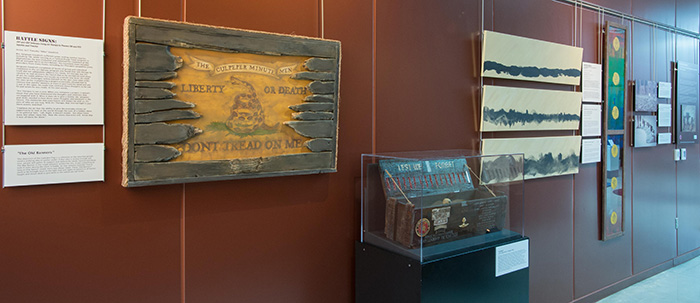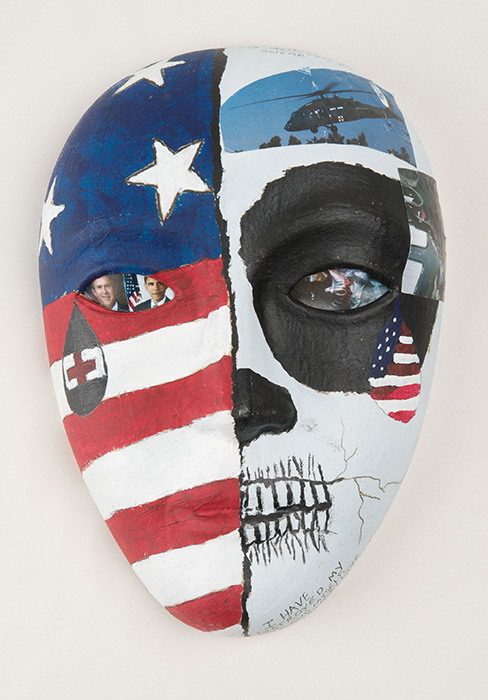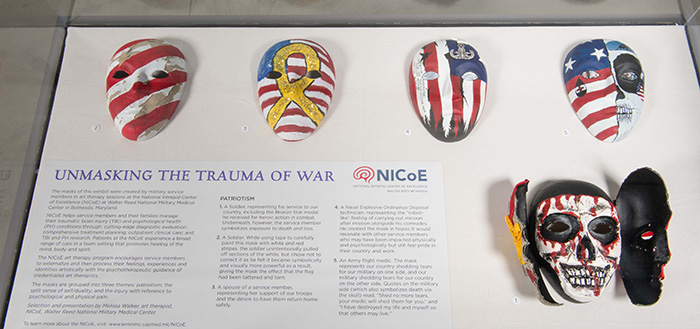Wounded Warriors' Art Therapy Exhibit Opens at DoD Medical Museum
By NMHM Public Affairs
Silver Spring, Md. – "Battle Signs: Using Art Therapy to Process TBI and PTS Injuries and Trauma," an exhibit featuring artworks produced by Wounded Warriors as part of an art therapy program, opened at the National Museum of Health and Medicine (NMHM), Silver Spring, Maryland, on June 30, 2017. "Battle Signs" will be on display at NMHM through September 2017.
The veteran-produced artwork was coordinated by the art therapy program at Intrepid Spirit One (ISO) at Fort Belvoir Community Hospital. The ISO at Fort Belvoir supports active-duty service members in rehabilitative treatment for traumatic brain injury and psychological health conditions through interdisciplinary treatment.
The show's title is reflective of a brain trauma indicator known as "Battle's sign," named for English physician William Henry Battle. As the artists wrote for the introduction to the exhibit, "Like Traumatic Brain Injury and Post Traumatic Stress injuries, Battle's signs often take time to show their impact upon an individual. This display of work and art are the Veterans' processing of loss of friends and identity/guilt/grief, and a multitude of other struggles war and combat have placed upon them."
Artists included in the exhibit are Army Sgt. Timothy Goodrich; Marine Corps Gunnery Sgt. Zachary A. Burgart; Army Sgt. Joshua Ferguson (Ret.) with photographer and former Navy PO2 Benjamin T. Stone; Marine Corps Sgt. Andrew Lavoie (Ret.); and Army Sgt. Jonathan Meadows (Ret.). Several works by an anonymous artist are included. All (except Stone) are patients at Intrepid Spirit One. Jacqueline Jones, an art therapist in the Creative Arts Therapies program at ISO, is also featured in the installation.
"I can say from my own experience that not all treatments are equal," said Goodrich. "Not all treatment plans are effective. In my care, this was apparently evident to everyone. Everyone, except me. I truly thought there was no road home for me. The day I turned back was the day I surrendered to the process of art therapy."
"Art therapy tends to promote process-oriented artmaking, meaning work created is typically not intended to be displayed," said Jones. "However, there are service members who create art products that they want to share publicly. It is our hope that sharing this collection of artwork will lead to greater understanding of the invisible wounds of war and of the military experience, as well as the significance of artmaking in the healing journey."
"Hosting this powerful collection allows NMHM to advance our missions of illuminating the nature of military medical care and research," said Adrianne Noe, Ph.D., NMHM director. "We offer not only an opportunity for service members, their families, friends, and the public to enhance their appreciation of these complex processes; we also provide a unique scientific and historical context for that understanding."
According to Intrepid Spirit One, art therapy is one of the treatments offered to support service members in their healing. Through group and individual art therapy sessions, service members engage in the creative process and artmaking that supports clinical goals to promote deeper insight and self-awareness by providing a safe platform for self-expression and processing of issues related to injury, identity, trauma, grief, moral injury, and pain. This leads to a greater ability to experience positive emotions and an improved quality of life.
NMHM previously featured an art therapy exhibit from the National Intrepid Center of Excellence (NICoE) at Walter Reed National Military Medical Center. A selection of masks from the NICoE program was on display from August through September 2016. The masks were made in art therapy sessions by military service members at the NICoE, as a conduit to artistically externalize and then process their feelings, experiences and identities with the psychotherapeutic guidance of credentialed art therapists. The masks were grouped into three themes: the split sense of self/duality, patriotism, and the injury with reference to psychological and physical pain. Read more about that previous exhibit online on the museum website.
On Sunday, August 27, NMHM will host a special public program featuring the artists and the art therapy program. Follow NMHM on Facebook for event information as it becomes available.
NMHM is an element of the Defense Health Agency-Research and Acquisition Directorate. Fort Belvoir Community Hospital is part of the National Capital Region Medical Directorate of the Defense Health Agency.
Click any photo to view larger version








